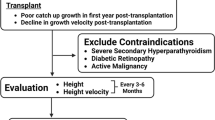Summary
There is a high frequency of Leydig cell tumors associated with hypercalcemia in the aged Fischer 344 rat. We studied a transplantable tumor cell line (Rice D-6) which is associated with hypercalcemia, hypercalciuria, hypophosphatemia, renal phosphate wasting, increased urinary cyclic adenosine monophosphate (AMP) excretion, absence of bone metastases, increased osteoclastic bone resorption, and suppressed immunoreactive parathyroid hormone (iPTH) concentrations. We examined the ability of dichloromethylene diphosphonate (Cl2MDP) to lower serum calcium and decrease the parameters of increased bone resorption. We used this drug also as a pharmacologic tool to determine the relationship of hypercalcemia and increased bone resorption to the abnormalities in renal tubular function associated with the humoral hypercalcemia of malignancy.
Daily administration of Cl2MDP before development of hypercalcemia, in doses from 2.5–40 mg/kg body weight subcutaneously, delayed and suppressed both the hypercalcemia and hypercalciuria. There was an increase in bone mass and decrease in both osteoclast number and activity compared with bones from untreated tumor-bearing animals. The urinary hydroxyproline excretion in treated animals declined towards the normal range. There were no significant effects on serum phosphorus, urine phosphorus, or urine cyclic AMP excretion.
These data suggest that Cl2MDP reverses the increased bone resorption that occurs in the humoral hypercalcemia of malignancy, and confirms that diphosphonates are effective agents in the prevention and treatment of increased bone resorption associated with malignant disease. They also suggest that renal phosphate wasting and increased urinary cyclic AMP excretion are not directly related to the hypercalcemia.
Similar content being viewed by others
References
Mundy GR 1978 Calcium and cancer. Life Sci 23:1735–1744
Martin TJ, Atkins D (1979) Biochemical regulators of bone resorption and their significance in cancer. Essays Med Biochem 4:49–82
Stewart AF, Horst R, Deftos LJ, Cadman EC, Lang R, Broadus AE (1980) Biochemical evaluation of patients with cancer associated with hypercalcemia: evidence for humoral and non-humoral groups. N Engl J Med 303:1377–1383
Rude RK, Sharp CF Jr, Fredericks RS, Oldham SB, Elbaum N, Link J, Irwin L, Singer FR (1981) Urinary and the nephrogenous adenosine 3',5'-monophosphate in the hypercalcemia of malignancy. J Clin Endocrinol Metab 52:765–771
Sica D, Martodam R, Aronow J, Mundy G (1981) The relationship between hypercalcemia and urinary cyclic AMP in the humoral hypercalcemia of malignancy. In: Proceedings of the Third Annual Scientific Meeting of the American Society for Bone and Mineral Research. p 30A
Francis MD, Russell RGG, Fleisch H (1969) Diphosphonates inhibit formation of calcium phosphate crystals in vitro and pathological calcification in vivo. Science 165:1264–1266
Fleisch H, Russell RGG, Francis MD (1969) Diphosphonates inhibit hydroxyapatite dissolution in vitro and bone resorption in tissue culture and in vivo. Science 165:1262–1264
Altman RD, Johnston CC, Khairi MRA, Wellman H, Serafini AN, Sankey RR (1973) Influence of disodium etidronate on clinical and laboratory manifestations of Paget's disease of bone (osteitis deformans). N Engl J Med 289:1379–1384
Frijlink WB, Bijvoet OLM, te Velde J, Heynen G (1979) Treatment of Paget's disease with (3-amino-1-hydroxy propylidene)-1,1-bisphosphonate (A.P.D.). Lancet 1:799–803
Meunier PJ, Chapuy MC, Alexandre C (1979) Effects of disodium dichloromethylene diphosphonate on Paget's disease of bone. Lancet 2:489–492
Van Breukelen FJM, Bijvoet OLM, Van Oosterom AT (1979) Inhibition of osteolytic bone lesions by (3-amino-1-hydroxypropylidene)-1,1-biphosphonate (ADP). Lancet i:803–805
Siris ES, Sherman WH, Baquiran DC, Schlatterer JP, Osserman EF, Canfield RE (1980) Effects of dichloromethylene diphosphonate on skeletal mobilization of multiple myeloma. N Engl J Med 302:310–315
Chapuy MC, Meunier PJ, Alexandre CM, Vignon EP (1980) Effects of disodium dichloromethylene diphosphonate on hypercalcemia produced by bone metastases. J Clin Invest 65:1243–1247
Fiske CH, Subbarow Y (1925) The colorimetric determination of phosphorus. J Biol Chem 66:375–400
Larsen K (1972) Creatinine assay by a reaction-kinetic principle. Clin Chem Acta 41:209
Steiner AL, Parker CW, Kipnis DM (1972) Radioimmunoassay for cyclic nucleotides. J Biol Chem 247:1106–1113
Nobbs BT, Walker AW, Davies TJ (1975) A simplified method for the estimation of urinary total hydroxyproline. Clin Chim Acta 64:219–221
Bordier PhJ, Chot S Tun (1972) Quantitative histology of metabolic bone disease. Clin Endocrinol Metab 1:197–215
Schussler GC, Verso MA, Nemoto T (1972) Phosphaturia in hypercalcemic breast cancer patients. J Clin Endocrinol Metab 35:497–504
Douglas DL, Russell RGG, Preston CJ, Preston FE, Duckworth T, Kanis JA, Prenton MA, Woodhead JS (1980) Effect of dichloromethylene diphosphonate in Paget's disease of bone and in hypercalcemia due to primary hyperparathyroidism or malignant disease. Lancet 11:1043–1047
Wasserman RH, Corradino RA, Taylor AN, Morrisey RL (1971) Intestinal calcium absorption, vitamin D, adaptation, and the calcium binding protein. In: Nichols G and Wasserman RH (eds) Cellular Mechanisms for Calcium Transfer and Homeostasis, Academic Press, New York, pp 293–312
Jacobs TP, Siris ES, Bilezikian JP, Baquiran DC, Shane E, Canfield RE (1981) Hypercalcemia of malignancy: treatment with intravenous dichloromethylene diphosphonate. Ann Intern Med 94:312–316
Shane E, Baquiran DC, Bilezikian JP (1981) Effects of dichloromethylene diphosphonate on serum and urinary calcium in primary hyperparathyroidism. Ann Intern Med 95:23–27
Jung A, Bornand J, von Ouwenaller C, Chantraine A, Donath A (1981) Effect of diphosphonates on tumor-induced osteolysis in animals and in humans. In: Cohn DV, Talmage RV, Matthews JL (eds) Hormonal control of calcium metabolism, International Congress Series 511, Excerpta Medica, pp 422
Author information
Authors and Affiliations
Rights and permissions
About this article
Cite this article
Martodam, R.R., Thornton, K.S., Sica, D.A. et al. The effects of dichloromethylene diphosphonate on hypercalcemia and other parameters of the humoral hypercalcemia of malignancy in the rat leydig cell tumor. Calcif Tissue Int 35, 512–519 (1983). https://doi.org/10.1007/BF02405086
Issue Date:
DOI: https://doi.org/10.1007/BF02405086




